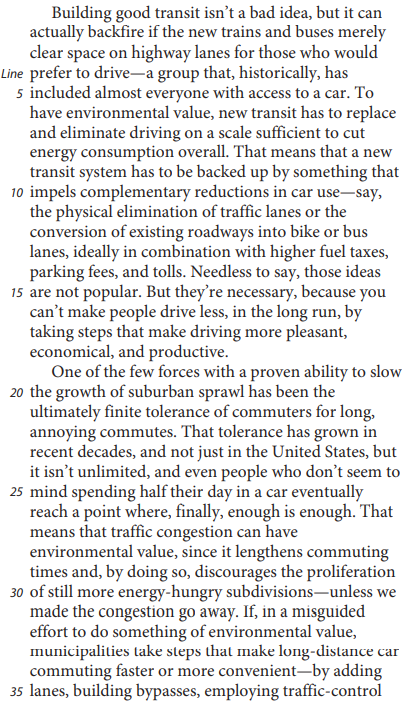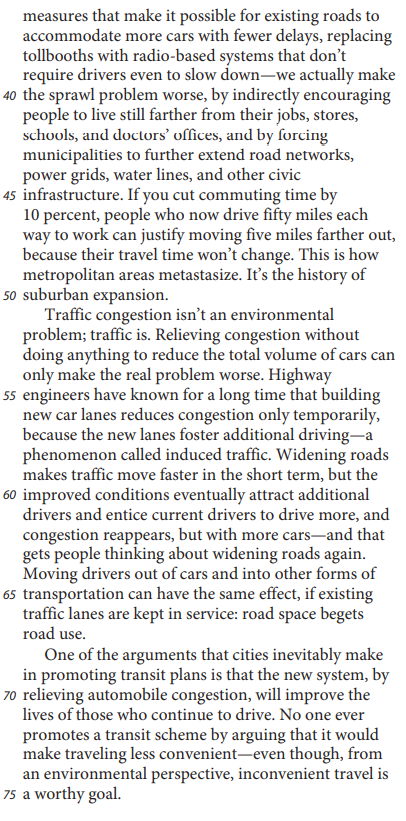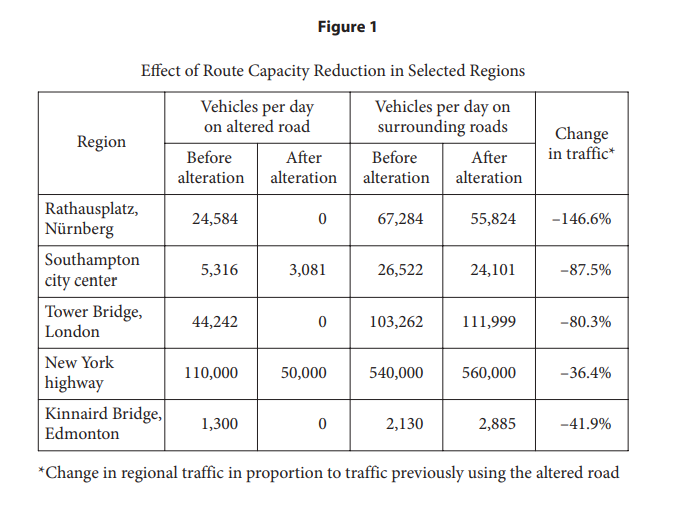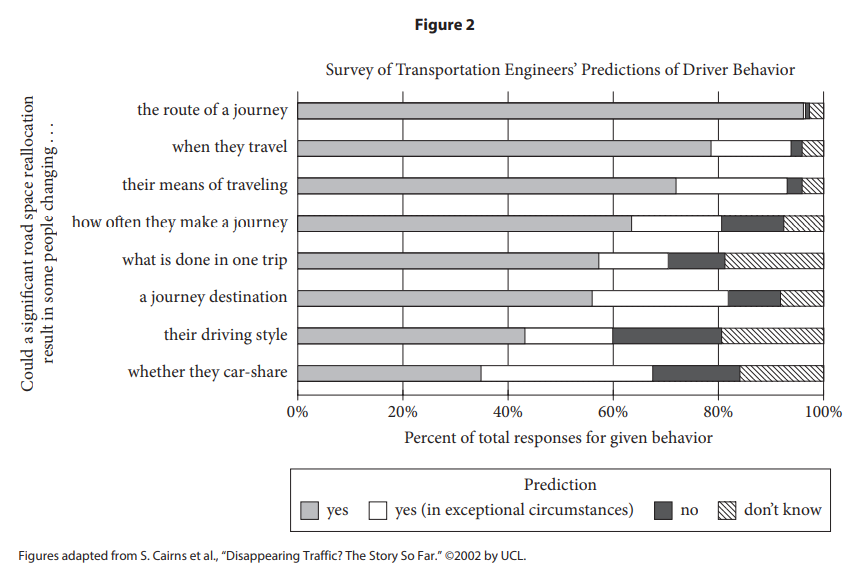SAT (Scholastic Assessment Test) is a standard test, used for taking admission to undergraduate programs of universities or colleges of the United States. SAT is developed and published by the College Board, an organization in the United States, administered by the Educational Testing Service. In this article of AKVTutorials, you will get SAT Reading Prep Test 47 | SAT 2024 Online Tutor AMBiPi.
SAT Reading Practice Passage
This passage is adapted from David Owen, The Conundrum: How Scientific Innovation, Increased Efficiency, and Good Intentions Can Make Our Energy and Climate Problems Worse. ©2011 by David Owen.




SAT Reading Comprehension Practice Test Questions
SAT Practice Test 47 Question No 1
The main purpose of the passage is to
Option A: provide support for the claim that efforts to reduce traffic increase traffic.
Option B: dispute the widely held belief that building and improving mass transit systems is good for the environment.
Option C: discuss the negative environmental consequences of car-focused development and suburban sprawl.
Option D: argue that one way to reduce the negative environmental effects of traffic is to make driving less agreeable.
SAT Practice Test 47 Answer No 1
Show/Hide Answer
Option D :
Throughout the passage, the author contends that efforts to make driving more unpleasant can curtail the negative environmental effects of car use, such as the rapid growth of “energy-hungry subdivisions.” According to the second paragraph, “one of the few forces with a proven ability to slow the growth of suburban sprawl has been the ultimately finite tolerance of commuters for long, annoying commutes.” Consequently, according to the last paragraph, “from an environmental perspective, inconvenient travel is a worthy goal.” Thus the main purpose of the passage is to argue that one way to reduce the negative environmental effects of traffic is to make driving less agreeable.
Choice A is incorrect because the author introduces the claim that efforts to reduce traffic increase traffic as a supporting point, not as the main purpose of the passage. Choice B is incorrect because, in the second paragraph, the author does dispute the environmental value of making car travel more convenient, but this isn’t the main purpose of the passage. Choice C is incorrect because the negative environmental consequences of car-focused development and suburban sprawl are supporting details of the passage, not its main purpose.
SAT Practice Test 47 Question No 2
Which choice best supports the idea that the author assumes that, all things being equal, people would rather drive than take mass transit?
Option A: Lines 1-5 (“Building… car”)
Option B: Lines 5-8 (“To have… overall”)
Option C: Lines 15-18 (“But they’re… productive”)
Option D: Lines 19-22 (“One… commutes”)
SAT Practice Test 47 Answer No 2
Show/Hide Answer
Option A :
In the first paragraph, the author states, “Building good transit isn’t a bad idea, but it can backfire if the new trains and buses merely clear space on highway lanes for those who would prefer to drive—a group that, historically, has included almost everyone with access to a car.” In this sentence, the author bases his claim on the unintended consequences of building public transit on the expectation that most people would prefer to drive a car than take trains and buses. Hence this sentence best supports the idea that the author assumes that, all things being equal, people would rather drive than take mass transit.
Choices B, C, and D are incorrect because the cited lines don’t provide the best support for the idea that the author assumes that, all things being equal, people would rather drive than take mass transit. Instead, they argue that to have positive environmental effects, new transit options have to persuade a substantial number of people not to drive (choice B), contend that unpopular efforts to make driving less convenient are necessary to reduce driving (choice C), and connect increased commute times to a reduction in suburban sprawl (choice D).
SAT Practice Test 47 Question No 3
As used in line 9, “backed up” most nearly means
Option A: supported.
Option B: copied.
Option C: substituted.
Option D: jammed.
SAT Practice Test 47 Answer No 3
Show/Hide Answer
Option A :
The first paragraph states, “That means that a new transit system has to be backed up by something that impels complementary reductions in-car use.” In other words, new public transportation initiatives need to be supported, or reinforced, by policies that reduce car use. Thus “backed up,” as used in the passage, most nearly mean supported.
Choices B, C, and D are incorrect because in the context of the passage, “backed up” means supported, not copied (choice B), substituted (choice C), or jammed (choice D).
SAT Practice Test 47 Question No 4
In the first paragraph, the author concedes that his recommendations are
Option A: costly to implement.
Option B: not widely supported.
Option C: strongly opposed by experts.
Option D: environmentally harmful in the short term.
SAT Practice Test 47 Answer No 4
Show/Hide Answer
Option B :
In the first paragraph, the author introduces some proposals for reducing car traffic by making driving slower and less convenient. However, he also acknowledges that “those ideas are not popular.” Thus, in the first paragraph, the author concedes that his recommendations aren’t widely supported.
Choice A is incorrect because, in the first paragraph, the author doesn’t indicate that his recommendations are costly to implement. Choice C is incorrect because the author concedes that his recommendations are unpopular with the general public, not strongly opposed by experts. Choice D is incorrect because the author suggests that his recommendations are environmentally beneficial in the long term, not environmentally harmful in the short term.
SAT Practice Test 47 Question No 5
Based on the passage, how would the author most likely characterize many attempts to improve traffic?
Option A: They are doomed to fail because most people like driving too much to change their habits.
Option B: They overestimate how tolerant people are of long commutes.
Option C: They are well-intentioned but ultimately lead to environmental harm.
Option D: They will only work if they make driving more economical and productive.
SAT Practice Test 47 Answer No 5
Show/Hide Answer
Option C :
In the second paragraph, the author argues that “if, in a misguided effort to do something of environmental value, municipalities take steps that make long-distance car commuting faster or more convenient . . . we make the sprawl problem worse.” That is measures that make driving more convenient harm the environment because they encourage more people to live in suburban developments, which represents wasteful expansion in his view. Therefore, based on the passage, the author would most likely characterize many attempts to improve traffic as well-intentioned but ultimately leading to environmental harm.
Choices A, B, and D are incorrect because the author doesn’t characterize attempts to improve traffic as doomed to fail due to drivers’ reluctance to change their behavior (choice A), as overestimating drivers’ tolerance of long commutes (choice B), or as viable only if they make driving more economical and productive (choice D).
SAT Practice Test 47 Question No 6
Which choice provides the best evidence for the answer to the previous question?
Option A: Lines 8-14 (“That… tolls”)
Option B: Lines 22-26 (“That… enough”)
Option C: Lines 31-40 (“If, in… worse”)
Option D: Lines 64-67 (“Moving… use”)
SAT Practice Test 47 Answer No 6
Show/Hide Answer
Option C :
The previous question asks how the author would most likely characterize many attempts to improve traffic. The answer, that the author would most likely characterize such attempts as well-intentioned but ultimately leading to environmental harm, is best supported in the second paragraph: “If, in a misguided effort to do something of environmental value, municipalities take steps that make long-distance car commuting faster or more convenient—by adding lanes, building bypasses, employing traffic-control measures that make it possible for existing roads to accommodate more cars with fewer delays, replacing tollbooths with radio-based systems that don’t require drivers even to slow down—we actually make the sprawl problem worse.”
Choices A, B, and D are incorrect because the cited lines don’t provide the best evidence for the answer to the previous question. Instead, they assert that public transit improvements must be supported by measures to reduce car use (choice A), indicate that tolerance for long commutes have grown recently, but has a natural limit (choice B), and elaborate on why improvements in public transport can fail to decrease road use (choice D).
SAT Practice Test 47 Question No 7
According to the passage, reducing commuting time for drivers can have which of the following effects?
Option A: Drivers become more productive employees than they previously were.
Option B: Mass transit gets extended farther into suburban areas than it previously was.
Option C: Mass transit carries fewer passengers and receives less government funding than it previously did.
Option D: Drivers become more willing to live farther from their places of employment than they previously were.
SAT Practice Test 47 Answer No 7
Show/Hide Answer
Option D :
The second paragraph discusses how efforts to make commuting more convenient can have the unintended consequence of encouraging people to live farther away from their jobs: “If you cut commuting time by 10 percent, people who now drive fifty miles each way to work can justify moving five miles farther out, because their travel time won’t change.” Therefore, according to the passage, reducing commuting time for drivers can have the effect of making drivers more willing to live farther from their places of employment.
Choices A, B, and C are incorrect because the passage doesn’t suggest that reducing commuting time can make drivers more productive employees (choice A), can cause mass transit to be extended farther into suburban areas (choice B), or can result in less government funding for mass transit (choice C).
SAT Practice Test 47 Question No 8
As used in line 72, “promotes” most nearly means
Option A: upgrades.
Option B: serves.
Option C: advocates.
Option D: develops.
SAT Practice Test 47 Answer No 8
Show/Hide Answer
Option C :
The last paragraph asserts, “No one ever promotes a transit scheme by arguing that it would make traveling less convenient.” In other words, nobody advocates, or pushes for, changes to the transportation system by arguing that they would make travel less convenient. Thus “promotes,” as used in the passage, most nearly means advocates.
Choices A, B, and D are incorrect because in the context of the passage, “promotes” means advocates, not upgrades (choice A), serves (choice B), or develops (choice D).
SAT Practice Test 47 Question No 9
According to figure 1, how many vehicles traveled on the altered road through the Southampton city center per day before the route was altered?
Option A: 3,081
Option B: 5,316
Option C: 24,101
Option D: 26,522
SAT Practice Test 47 Answer No 9
Show/Hide Answer
Option B :
Figure 1 presents data related to the effect of route capacity reduction on selected regions. In the row pertaining to Southampton city center, the number 5,316 appears under the heading “Vehicles per day on altered road” in the column that specifies “Before alteration.” Thus, according to figure 1, the number of vehicles that traveled on the altered road through Southampton city center per day before the route was altered is 5,316.
Choice A is incorrect because 3,081 is the number of vehicles per day that traveled on the Southampton city center road after it was altered, not before. Choice C is incorrect because 24,101 is the number of vehicles per day that traveled on roads surrounding the Southampton city center road after it was altered. Choice D is incorrect because 26,522 is the number of vehicles that traveled on roads surrounding the Southampton city center road before it was altered.
SAT Practice Test 47 Question No 10
Do the data in figure 1 support or weaken the argument of the author of the passage, and why?
Option A: Support, because the data show that merely moving drivers out of cars can induce traffic.
Option B: Support, because the data show that reducing road capacity can lead to a net reduction in traffic.
Option C: Weaken, because the data show that in some cases road alterations lead to greater traffic on surrounding roads.
Option D: Weaken, because the data show that traffic reductions due to road alterations tend to be brief.
SAT Practice Test 47 Answer No 10
Show/Hide Answer
Option B :
In the first paragraph, the author of the passage argues that “to have environmental value . . . a new transit system has to be backed up by something that impels complementary reductions in-car use—say, the physical elimination of traffic lanes.” According to figure 1, reducing route capacity resulted in a net reduction in regional traffic in all five areas studied. Therefore, the data in figure 1 support the author’s argument because the data show that reducing road capacity can lead to a net reduction in traffic.
Choice A is incorrect. Figure 1 data support the author’s argument that route capacity reduction results in a reduction of car use, but the figure doesn’t provide data relating to the “induced traffic” phenomenon. Choices C and D are incorrect because figure 1 data support, not weaken, the author’s argument that route capacity reduction such as elimination of traffic lanes results in the reduction of traffic.



